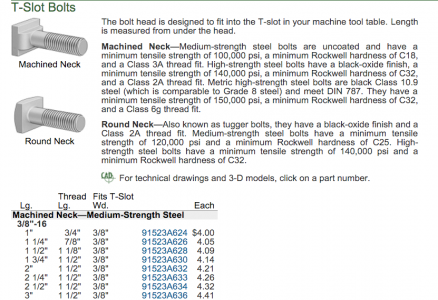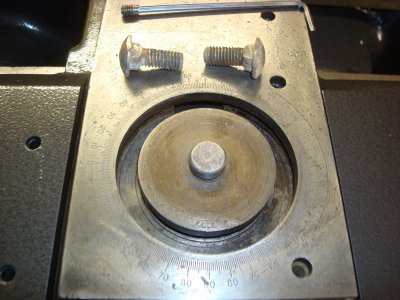Guys I need couple of carriage bolts for my swivel compound slide that has some strength to them.I did google bolts and found out that fine thread is stronger than coarse thread.So I went to McMaster-Carr and there is not a lot of selection for carriage bolts.Either grade 5 or 316 Stainless steel in fine or coarse threads,so which one is stronger?Thanks guys----kroll
-
Welcome back Guest! Did you know you can mentor other members here at H-M? If not, please check out our Relaunch of Hobby Machinist Mentoring Program!
You are using an out of date browser. It may not display this or other websites correctly.
You should upgrade or use an alternative browser.
You should upgrade or use an alternative browser.
3/8 Bolts W/strength???
- Thread starter Kroll
- Start date
- Joined
- Feb 1, 2015
- Messages
- 9,621
Guys I need couple of carriage bolts for my swivel compound slide that has some strength to them.I did google bolts and found out that fine thread is stronger than coarse thread.So I went to McMaster-Carr and there is not a lot of selection for carriage bolts.Either grade 5 or 316 Stainless steel in fine or coarse threads,so which one is stronger?Thanks guys----kroll
Check out the about at the top of this page.http://www.mcmaster.com/#carriage-and-plow-bolts/=10jhsrs The Grade 5 are approximately 30% stronger than the 8-18 or 316
D
Douglasr
Forum Guest
Register Today
Look for a grade 8
T
TOOLMASTER
Forum Guest
Register Today
............... see below
Last edited by a moderator:
- Joined
- Apr 28, 2014
- Messages
- 3,590
Can we see a picture of where you need it to go?
T
TOOLMASTER
Forum Guest
Register Today
T
TOOLMASTER
Forum Guest
Register Today
- Joined
- Nov 23, 2014
- Messages
- 2,607
Take the tensile strength times the cross section area for the maximum load (?). I recall stress being force per unit area. So stress times the area should give the force.
For example, the tap drill for a 3/8" x 16 is 5/16" or a diameter of 0.3125". Pi x D / 4 is the area or 0.0767 sq. inches. For a 100,000 psi material that'd give a load of 7670 lbs. I'm assuming no stress riser from the thread (like a sharp notch). A fine pitch 3/8" x 24 bolt has a larger cross section so it would break at a higher load.
As I recall from my mechanics class, tensile strength is the top of the curve for stress vs. strain. The material has an elastic region where it deflects proportionally to the load. Then it starts to permanently deform (plastic region). When the deformation (strain) is a 0.2% of the original length, that load (stress or force/unit area) is the yield strength.
The curve knees over at that point and reaches a peak (tensile strength). At which point it starts moving downhill until it ultimately fractures. Google stress vs. strain diagram for more info (probably already more than you want to know . . .).
Or ignore most of what I typed and go for the grade 8 bolts recommended above!
Bruce
For example, the tap drill for a 3/8" x 16 is 5/16" or a diameter of 0.3125". Pi x D / 4 is the area or 0.0767 sq. inches. For a 100,000 psi material that'd give a load of 7670 lbs. I'm assuming no stress riser from the thread (like a sharp notch). A fine pitch 3/8" x 24 bolt has a larger cross section so it would break at a higher load.
As I recall from my mechanics class, tensile strength is the top of the curve for stress vs. strain. The material has an elastic region where it deflects proportionally to the load. Then it starts to permanently deform (plastic region). When the deformation (strain) is a 0.2% of the original length, that load (stress or force/unit area) is the yield strength.
The curve knees over at that point and reaches a peak (tensile strength). At which point it starts moving downhill until it ultimately fractures. Google stress vs. strain diagram for more info (probably already more than you want to know . . .).
Or ignore most of what I typed and go for the grade 8 bolts recommended above!
Bruce
Last edited:



